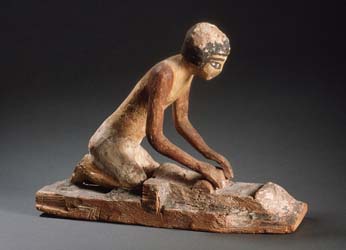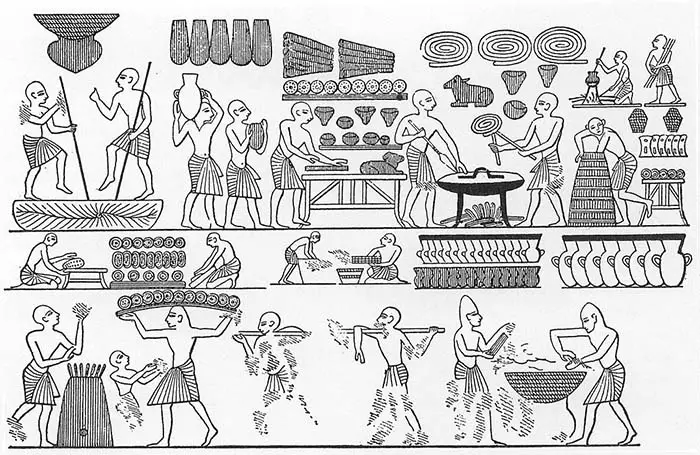Ancient Egyptian Recipes
Ancient Egypt lasted a long time and encompassed a great many cooking traditions and recipes. Looking at our own food over the past hundred years, we would barely recognize things our great grandparents ate on a daily basis. Egypt is much the same, except we're talking over the thousands of years. However, they were a key people in how food evolved among the ancient world. International trade also brought a great many novel processes and ingredients over time.
Bread
Ancient Egyptian bread was often made from barley, millet, and once it become available, wheat. Though not always combined, sometimes two or all three of these were used in a single recipe. Bread was a very simplistic form. Yeast did not exist in Egypt until well into the Middle Kingdom, so most loaves were takes on what we would consider today "flat" breads. And though it existed, yeast was not particularly popular until the New Kingdom era.
Bread consisted of only three simple ingredients:
- Flour made from barley, millet or wheat.
- Water
- Leavening: leavening to us is yeast, but Egypt used sourdough starters or spent brewery grain which, unknown to them, had yeast in it.
To this incredibly basic recipe, sometimes flavorings were added prior to baking. Sometimes flavors were added afterward. Sesame seed, honey, herbs, oil, egg washes, fruits and even sometimes bits of leftover chopped meat were added to help spice up these supplementary loaves.

© gichristof - Ancient Egyptian Food
To make ancient Egyptian bread, follow this recipe:
- Mix three parts flour to one part water. Mix with the hands until it forms a sticky dough lump. If needed, add more water. You're looking for the dough to pull away from the side of the bowl, as in normal bread.
- You may use yeast if you desire, but it is best to use a sourdough starter or ground brewery grain if available. You can grind brewery grain in a food processor.
- Allow to rise for thirty minutes, separate into rounds, place on a baking sheet and insert into a 300 degree oven. If you happen to have an outdoor fireplace that is food safe or barbecue grill these work wonderfully to recreate the same sorts of cooking environments these recipes came from.
- Cook for about 45 minutes. Check halfway through with a knife. When a knife comes out clean, pull your bread from the oven and let it cool.
- Slice like a pizza. It's perfect to serve with almost anything as a side, or, if having added meat or fruit to it, as a "sandwich" portion of food for lunch.

© Ashley Van Haeften - Woman grinding grains
Meats
This is where things get a little dicey. Though meat was regularly consumed by those with money, those who were not wealthy often survived on meals of beans and bread instead. Most towns and villages had hunters and fishermen, though the latter could be looked down upon by some of the more heavily religious communities.
Meat consumption was often same-day as the animal was killed. It was quick. It was simple. Ovens, in most of the period we are covering, did not account for the long periods it takes to properly heat meat. Instead, meats were smoked, cured with salt or pounded into jerky. On rare occasions meats were roasted, usually during festival times.
The most common meats in ancient Egypt were poultry. ², water fowl, and a few somewhat domesticated fowl that were running around at the time were the most popular. Eggs were not incredibly common, because birds laid so few at the time every year that it was better a hen hatch them than to waste them on a meal. After all, a full grown bird could certainly feed more people than a single runty egg.
You can make a simple chicken jerky in your oven. Simply Google until you find your favorite recipe. Use spices that were typically available to the Egyptians such as coriander, cumin or dip the finished product in almond oil or honey and roll in sesame seeds for an authentic Egyptian chicken dinner.

© annemarieangelo - Egyptian Spices
Sweets
Sweets were heavily eaten when they could be afforded. Among the most popular foods were honey, dates and stuffed shortbreads. These little stuffed shortbreads are still intensely popular today.
- Start with 2 cups of flour.
- Mix into this 1 whole stick of butter with your fingers to make a pastry base.
- When the butter and flour have combined, add a splash of orange juice, a splash of milk, and 1/2 cup of chopped hazelnuts, walnuts or almonds.
- Knead this into a soft, well mixed dough and place it aside.
- Using a food processor, combine 1/2 cup of dried figs and 1/2 cup of raisins until a paste.
- Add 1/4 cup of walnuts to this, as well as another splash of orange juice. The orange juice need not be exact, you simply need fluid for the filling to "stick".
- Blend.
- Add 1 and 1/2 teaspoons of sugar and mix with a spoon.
- Roll the dough into small disks, placing a dollop of filling in each.
- Pinch the crust together, leaving a small ventilation hole at the top or on a side.
- You may coat with butter or honey if you desire.
- Place these dough lumps on an oiled baking sheet and into a 350 degree oven for about 20-25 minutes.
- Cool before serving. These are excellent served with honey or powdered sugar.

Ancient Egyptian Bakery, court of Ramses III
Facts About Food and Drink Ancient Egypt:
- Bakers used to shape bread dough into various figures, including animals and humans.
- Ancient Egyptians made beer by half cooking barley, soaking it in water and leaving it to set. They had to strain the clumps of barley out before drinking it.
- When grinding grains, some of the stone used would wear away into the flour, which people would then eat. This often led to severe tooth erosion.

